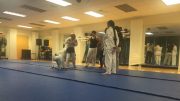Kristen King // Staff Writer
At the front of the class stands Scott Miller, the Capoeira instructor at FIU, in a black T-shirt and a pair of white abadás, the traditional term for the pants used by capoeiristas. Speaking to nearly 25 students, Miller leads them into the next move of the night: The Meia Lua de Compasso, or the half-moon in Portuguese.
As the class continues, the moves raise in level of difficulty, but Miller and his student instructors provide the class with assistance to adjust their bodies to do the moves properly. The next move of the night: Armada, or armed in Portuguese.
The way each student’s body moves is almost dancer-like, making it seem as though they are barely putting in effort.
But the effortless look is just students embodying the art form of Capoeira as its definition explains.
Capoeira is a Brazilian mixed martial art that combines elements like dancing, music and acrobatics in its practice. The art form originated from Angola and the Congo where African slaves came up with a way to disguise their fighting.
During these times, if slaves were caught fighting, they would either be arrested or tortured by police. Since Capoeira heavily favors a movement-based technique, people would never suspect that these men were fighting but rather dancing.
The Brazilian culture is one of the most important parts to understand and embrace about the class, according to club president, Risa Perea.
“There is such a long history of Capoeira and learning how everything originated makes it easier to practice the art form in the right way. For me, it’s a way of expressing yourself and feeling free even if you don’t feel like you are,” said Perea, who started the club in 2013.
Professor Miller ensures that his students understand the importance of the Brazilian culture by keeping them involved with hands-on experience.
A student instructor, who goes by the Capoeira name “Dinora,” explained that some of the students in the Capoeira club had just returned from a trip to Brazil during the summer.
“Professor wanted us to learn about the origins and history of this art form as well as develop in our practice. There’s levels in Capoeira, so once you surpass a new one you get a chord to record that achievement and go to Brazil to learn more about the next level,” she said.
Students then moved to the next move of the night: Roda, which means circle in Portuguese.
Here, students form one large circle and two students go in the middle at a time and perform the moves they have learned.
The purpose of this is not to hurt anyone, but to showcase skills.
In the middle of the circle stands Perea, who is small in her stature, standing at no more than 5-foot-2. In front of her is a Capoeira student who is at least six feet tall. They begin to roll.
As kicks are being thrown and ducked under, the realization that this isn’t necessarily about hurting people but instead outsmarting your opponent becomes more evident.
“Big or small doesn’t matter. In Capoeira, it’s about getting around your opponent and outmaneuvering them,” Perea said. “It can almost be compared to a chess game.”
This is a mindset seen throughout many combat sports, namely boxing and mixed martial arts. Two men or women are faced with the task of getting around their opponents to get their first shot off. The fluidity of Capoeira is what reinforces this approach within these sports.
Matthew Gonzalez, an FIU Capoeira club member, explained how practicing this art form helps him in his profession.
“I’m an amateur fighter and I’ve decided to do this because it’s rhythmic and effective,” Gonzalez said. “I can’t tell you how much it has helped with my movement in my fights. It definitely compliments my fighting style.”
At the end of the night, remaining members of the class meet to play traditional instruments and sing Portuguese songs.
Leaving class, Dinora spoke more about the name of the Capoeira club, which she quickly points to on her embroidered pants.
“We call ourselves ‘Capoeira Superação,’ which means to overcome adversity and always pushing yourself to the limit,” Dinora said. “Last year was pretty rough for us, with professor battling cancer and another one passing away, so we thought this name was the perfect way to show how strong we can be.”
Despite an unfortunate year, the Capoeira club members still makean effort to come to class.
For more information about FIU’s Capoeira club, visit www.capoeira.life or attend a class, which is held every Tuesday, Thursday and Sunday at MMC’s Wellness and Recreation Center.






Be the first to comment on "Club keeps Brazilian culture alive, teaches students how to ‘overcome adversity’"